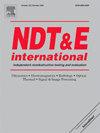用有界超声导波束反射评价焊接接头材料损伤
IF 4.5
2区 材料科学
Q1 MATERIALS SCIENCE, CHARACTERIZATION & TESTING
引用次数: 0
摘要
包含焊接接头和母板的焊板结构在工程领域中应用广泛。提出了一种利用有界超声导波(UGW)光束在母板中传播的反射效应来评估焊接接头损伤的新方法。从理论上初步分析了有界超重力波束从母板到焊接接头的反射特性。在此基础上,进行了有限元模拟,验证了利用有界超重力波束反射特性评估焊接接头材料损伤的可行性。考察了不同因素对反射场的影响,包括入射角和材料损伤程度(由杨氏模量量化)。结果表明,定义的损伤指数与材料的损伤程度有显著的相关性。为了解决实际工程应用问题,采用有界超宽光束对焊接接头表面损伤进行了模拟评估。在特定入射角下,损伤指数随杨氏模量比例因子的减小而显著增加。实验结果表明,聚偏氟乙烯(PVDF)梳状换能器能够有效地激发和捕获母板中有边界的UGW光束,能够有效地评估焊接接头的表面腐蚀损伤。随着腐蚀程度的增加,最大振幅和损伤指数呈显著的增加趋势,证明了母板入射有界超宽激光束的反射效应对评价焊接接头表面腐蚀损伤更为敏感和可靠。本研究为利用PVDF梳状换能器进行焊接接头损伤评估提供了理论基础、有限元模拟和实验验证,展示了其在实际工程应用中的巨大潜力。本文章由计算机程序翻译,如有差异,请以英文原文为准。
Evaluation of material damage in welded joints using reflection of a bounded ultrasonic guided wave beam
Welded-plate structures containing welded joints and parent plates are widely used in the engineering field. This paper presents a new method for assessing damage in welded joints by leveraging the reflection effect of a bounded ultrasonic guided wave (UGW) beam propagating in the parent plate. The reflection characteristics of the bounded UGW beam when it travels from the parent plate to the welded joint were initially analyzed theoretically. Subsequently, finite element (FE) simulations were conducted to assess the feasibility of using the reflection characteristics of the bounded UGW beam for material damage evaluation in the welded joint. The influence of different factors on the reflected field, including the incident angle and the extent of material damage (quantified by the reduced Young's modulus), was examined. It was observed that the defined damage index exhibited a significant correlation with the degree of material damage. To address practical engineering applications, a simulation of surface damage assessment in welded joints was conducted using a bounded UGW beam. The damage index showed a notable increase as the Young's modulus scaling factor decreased at a specific incident angle. Finally, the experimental results demonstrate that the polyvinylidene fluoride (PVDF) comb transducer can effectively excite and capture the bounded UGW beam in the parent plate, enabling the effective evaluation of surface corrosion damage in the welded joint. The significant increasing trend of the maximum amplitude and damage index with the increase of the corrosion level proves that the reflection effect of a bounded UGW beam incident from the parent plate is more sensitive and reliable for evaluating surface corrosion damage in the welded joint. This study provides a theoretical basis, FE simulation, and experimental validation of a bounded UGW beam using PVDF comb transducers for damage evaluation in welded joints, showcasing its tremendous potential for practical engineering applications.
求助全文
通过发布文献求助,成功后即可免费获取论文全文。
去求助
来源期刊

Ndt & E International
工程技术-材料科学:表征与测试
CiteScore
7.20
自引率
9.50%
发文量
121
审稿时长
55 days
期刊介绍:
NDT&E international publishes peer-reviewed results of original research and development in all categories of the fields of nondestructive testing and evaluation including ultrasonics, electromagnetics, radiography, optical and thermal methods. In addition to traditional NDE topics, the emerging technology area of inspection of civil structures and materials is also emphasized. The journal publishes original papers on research and development of new inspection techniques and methods, as well as on novel and innovative applications of established methods. Papers on NDE sensors and their applications both for inspection and process control, as well as papers describing novel NDE systems for structural health monitoring and their performance in industrial settings are also considered. Other regular features include international news, new equipment and a calendar of forthcoming worldwide meetings. This journal is listed in Current Contents.
 求助内容:
求助内容: 应助结果提醒方式:
应助结果提醒方式:


